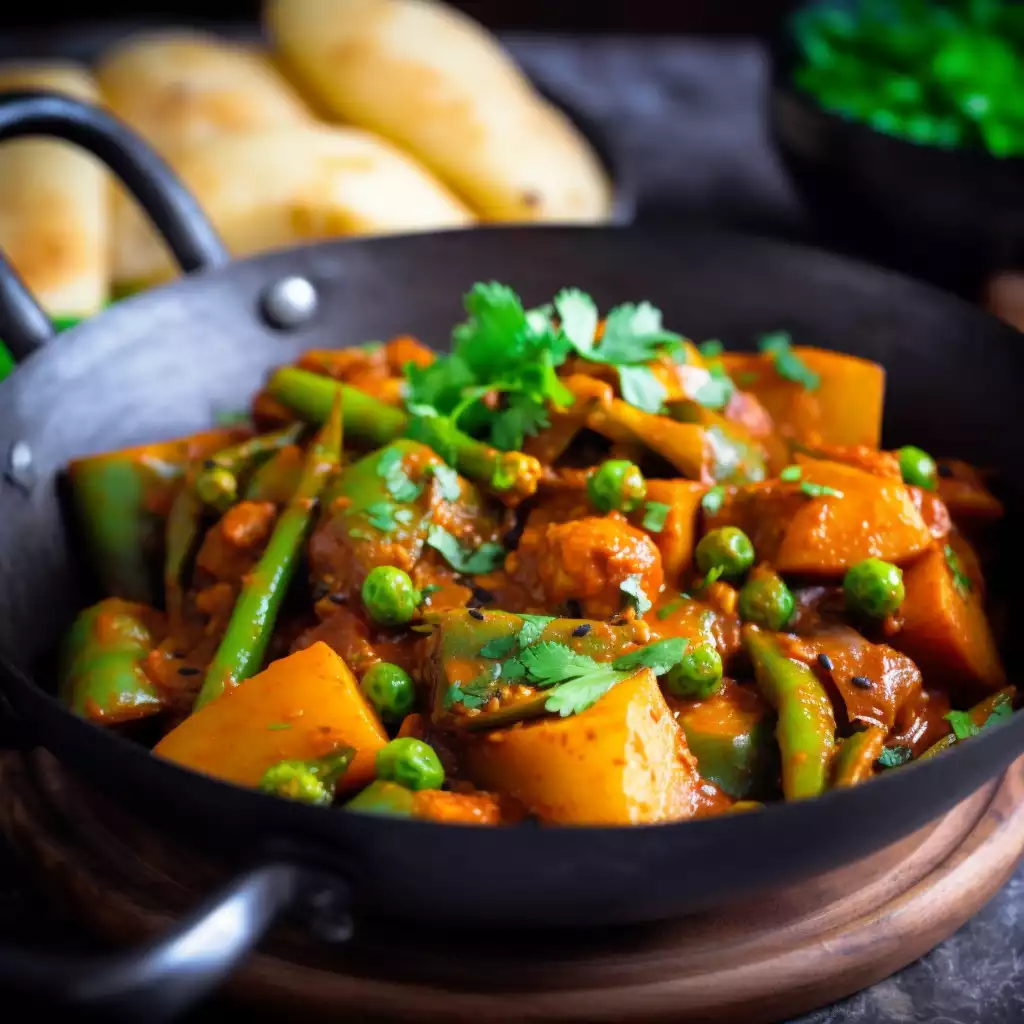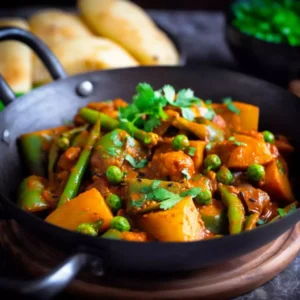
Vegetable Karahi, a colorful and flavorful dish originating from the heart of South Asia, is a delightful medley of vibrant vegetables and aromatic spices.
With its origins deeply rooted in the rich culinary traditions of the Indian subcontinent, this dish offers a tantalizing fusion of textures and tastes. Despite its exotic name, Vegetable Karahi is surprisingly simple to prepare, making it an ideal choice for both novice and seasoned cooks alike.
This recipe showcases a harmonious blend of potatoes, bell peppers, carrots, onions, garlic, ginger, and tomatoes, all cooked to perfection in a fragrant mix of spices.
The dish gets its name from the traditional karahi, a type of deep, circular cooking vessel widely used in South Asian cuisine. Each ingredient plays a crucial role in enhancing the overall flavor profile, resulting in a dish that is both wholesome and satisfying.
While Vegetable Karahi traditionally features a combination of potatoes, bell peppers, and carrots, feel free to customize the recipe based on your preferences and seasonal availability.
Whether served as a hearty main course or a flavorful side dish, Vegetable Karahi promises to tantalize your taste buds and transport you to the bustling streets of South Asia with every bite.
Expert Tip: For a smoky flavor, you can roast the bell peppers over an open flame or under the broiler before adding them to the dish.
Potatoes: Potatoes add a hearty texture to the dish and serve as a satisfying base. Their mild flavor allows them to absorb the aromatic spices, contributing to the overall richness of the dish.
Bell Peppers: With their vibrant colors and crisp texture, bell peppers not only enhance the visual appeal of Vegetable Karahi but also impart a subtle sweetness to the dish. The combination of green and red bell peppers adds depth and complexity to the flavor profile.
Carrots: Carrots bring a touch of sweetness and earthiness to the dish, complementing the other vegetables perfectly. Their vibrant orange hue adds visual interest to the ensemble.
Onion: Finely chopped onions form the flavor base of Vegetable Karahi, providing a savory foundation for the dish. When cooked until translucent, onions release their natural sweetness, balancing the spices and acidity of the tomatoes.
Garlic: Garlic adds a robust, pungent flavor to the dish, enhancing its overall depth and complexity. Finely chopped garlic cloves infuse the dish with aromatic goodness, elevating its taste profile.
Ginger: Fresh ginger lends a warm, peppery flavor to Vegetable Karahi, with subtle citrus undertones. Its aromatic presence adds brightness to the dish, enhancing its overall freshness.
Tomatoes: Tomatoes contribute acidity and tanginess to the dish, balancing the richness of the spices and vegetables. Diced tomatoes add a burst of color and juiciness, creating a luscious sauce that coats the vegetables.
Oil: Oil serves as the cooking medium for sautéing the vegetables and spices, imparting richness and depth to the dish. Choose a neutral oil with a high smoke point, such as vegetable or canola oil, for best results.
Cumin Seeds and Coriander Seeds: Cumin seeds and coriander seeds form the aromatic foundation of Vegetable Karahi, infusing the dish with warm, earthy flavors. Toasting the seeds in oil releases their essential oils, intensifying their fragrance and taste.
Turmeric Powder: Turmeric powder lends a vibrant yellow hue to Vegetable Karahi, while also adding warmth and depth of flavor. Its subtle bitterness balances the sweetness of the vegetables, creating a harmonious flavor profile.
Chili Powder: Chili powder adds a hint of heat to the dish, providing a delightful kick of spice. Adjust the amount according to your preference for spiciness, keeping in mind that a little goes a long way.
Salt: Salt enhances the natural flavors of the ingredients and helps to balance the overall taste of Vegetable Karahi. Season the dish to taste, adding salt gradually as needed.
Coriander: Fresh coriander leaves, also known as cilantro, add a burst of freshness and color to Vegetable Karahi. Sprinkle chopped coriander over the dish just before serving to brighten its appearance and flavor.
Dried Fenugreek Leaves: Dried fenugreek leaves, also known as kasuri methi, impart a distinctive aroma and flavor to Vegetable Karahi. Their slightly bitter, nutty taste enhances the complexity of the dish, adding a unique layer of depth.
Expert Tip: To enhance the richness of Vegetable Karahi, you can add a splash of coconut milk or cashew cream towards the end of cooking.
Expert Tip: For a restaurant-style finish, garnish Vegetable Karahi with a drizzle of melted ghee or clarified butter just before serving.
How spicy is Vegetable Karahi?
Vegetable Karahi can be adjusted to suit your preferred level of spiciness by varying the amount of chili powder used. Start with a small amount and adjust to taste.
Can I add other vegetables to Vegetable Karahi?
Yes, feel free to customize Vegetable Karahi by adding your favorite vegetables such as cauliflower, peas, or green beans. Just ensure that all the vegetables are cut into uniform pieces for even cooking.
Can I make Vegetable Karahi in advance?
Yes, Vegetable Karahi can be prepared in advance and stored in the refrigerator for up to 2-3 days. Simply reheat gently on the stovetop or in the microwave before serving.
Is Vegetable Karahi vegan-friendly?
Yes, Vegetable Karahi is naturally vegan as it contains only plant-based ingredients. It’s a delicious and satisfying option for vegans and vegetarians alike.
Can I freeze Vegetable Karahi?
While Vegetable Karahi can be frozen for longer storage, the texture of the vegetables may change slightly upon thawing. It’s best enjoyed fresh or stored in the refrigerator for short-term consumption.
Here are some more recipes for you to enjoy! If you my recipes don’t forget to rate and leave a comment.
If you have any recipe suggestions, please do not hesitate to ask me. A great way to stay in contact with me is through Instagram, Facebook, Twitter and YouTube. Don’t forget to tag me @CookwithNabeela in your recipe photos!

Subscribe now to receive my latest recipes directly in your inbox. Stay up-to-date and never miss out!

I love to cook! I want to share with you my favourite, delicious family-friendly recipes. I want to inspire you to create fantastic food for your family every day.
Latest comments (6)
You’ve got the tomatoes to be added at #5 and again at #8. I’ve just made it and put them in at #5, so we’ll see. But when are they supposed to go in?
Ah, thanks for catching that! The tomatoes should go in at step #5. Hope the recipe turned out great for you—let me know how it tasted!
It was delicious, and am about to make it again so came back to see whether you’d replied! Thank you.
Glad you loved it! Hope round two turns out just as tasty. Let me know how it goes—always happy to hear from you! 😊🔥
you haven’t listed the tomatoes in the recipe ingresdients
Apologies for the oversight! Thank you for pointing that out. Tomatoes are an essential ingredient for this recipe. I’ve updated the ingredient list to include them. 🙂